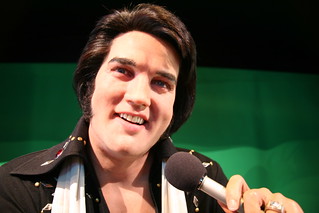 |
| Steven Tyler and Joe Perry performing live in concert (Photo credit: Wikipedia) |
Music critics in the 70s widely described Aerosmith as a vulgar, cheap imitation of the Rolling Stones. Steven Tyler was often nastily referred to as a "Mick Jagger Look-alike". Even with all that criticism and negativity being hurled their way, Aerosmith kept pushing ahead. Despite the critic's ill-informed opinions, Aerosmith turned out to be one of the most popular acts of the decade.
Aerosmith's band roots were planted back in 1970 when Joe Perry and Tom Hamilton met Steven Tyler. Perry and Hamilton were already playing in a band called The Jam Band. Drummer Joey Cramer and guitarist Ray Tabano were the next members added to the band. By 1971 though, changes were already happening in the band and Tabano was replaced by Brad Whitford.
By '72 Aerosmith had developed a loyal following of fans in the Boston area. They were gaining attention from recording studios as well and landed a deal with Columbia Records. It took three years for the band to finally break into the mainstream, but the album 'Toys In The Attic' was the break they needed. Aerosmith assured their place in rock and roll history with their next album titled, 'Rocks'.
Fame and fortune, as it often does in rock and roll, brought addiction to the band in the mid 70's. Steven Tyler and Joe Perry were dubbed rocks "Toxic Twins" due to their excessive drug and alcohol use. Their drug troubles and the internal conflicts between members nearly destroyed what the band had built in the late 70's. The music they produced during these troubled times wasn't nearly as good either.
From 1977 to 1979, Aerosmith put out the 'Draw The Line' and 'Live! Bootleg' albums. Neither garnered much commercial success for the band though. Whether it was the drugs or the tension between Joe Perry and Steven Tyler, things were not good in the Aerosmith camp. After recording the studio album entitled, 'Night In The Ruts', Perry left the band to start the Joe Perry Project. Perry was replaced and the band set out on a tour to promote the new album.
The early 80's brought challenge after challenge to the Aerosmith band members. The music wasn't the same and the band's commercial success was in a serious rut. Despite several album and tour attempts, Aerosmith was in danger of losing its mega-rock band status. Steven Tyler is reported to have been so high that he passed out on-stage at least twice during this time. The negative publicity and downward spiral seemed to be putting a halt any future Aerosmith had.
By 1984, Joe Perry and Brad Whitmore had rejoined Aerosmith and the band was signed under a new record label. Their reunion tour dubbed "The Back In The Saddle Tour" brought in crowds of fans. Still, Tyler and the others hadn't changed their partying habits much and old problems began to resurface.
Finally, in '86, Steven Tyler was nearly forced into drug rehab. Tim Collins, Aerosmith's manager was certain that if Tyler didn't clean up his act, the band would be in serious trouble. Over the next couple of years, Joe Perry and the rest of the band followed Tyler's lead and entered rehab. Collins supposedly made the band a promise that if they completed rehab, he could make Aerosmith the biggest rock band in the world by 1990.
With rehab behind them, Aerosmith set to work on an album that would once again get them the attention they deserved. Their comeback album, 'Done With Mirrors' did moderately well, but it wasn't a blockbuster. It wasn't until Tyler and Perry teamed up with Run DMC for a remake of "Walk This Way" that Aerosmith got the attention of the younger generation. While that single was peaking on the charts, Aerosmith released their 'Permanent Vacation' album.
'Permanent Vacation' was the monster album Aerosmith had been trying to create. It spawned three top 20 singles and videos. 'Dude Looks Like A Lady' topped the charts at number 14, 'Angel' soared to number 3 and 'Rag Doll' made it up to the number 17 spot. By all accounts, Aerosmith was back in their groove.
Aerosmith proved that they were back in a big way when they followed up 'Permanent Vacation' with 'Pump'. Settling in at the number 5 spot on the charts, 'Pump' went quadruple-platinum. "Janies Got A Gun", one of the singles from the album, earned Aerosmith a Best Rock Performance Grammy in 1990.
With their mega-rockstar status fully restored, Aerosmith spent the rest of the nineties doing what they do best. They produced several hit albums including 'Get a Grip' which hit Number One. In 1994 Aerosmith's greatest-hits package, Big Ones made it up to number six. Three years later, 'Nine Lives' entered the charts at number one.
In 2001, Aerosmith was inducted into the Rock and Roll Hall Of fame. There's no doubt that these hard-core rockstars have earned it in every way possible. The coveted award was received just as Aerosmith's album 'Just Push Play' and the number 7 single, 'Pink' were released.
These days, Aerosmith has been doing what they always do, but with a twist. They're featured in one of the hottest new video games out there. And yes, they've still got their issues with addictions. Recently, Steven Tyler checked himself into rehab once again. Some habits die hard, but a great rock band like Aerosmith will live on forever.
|















